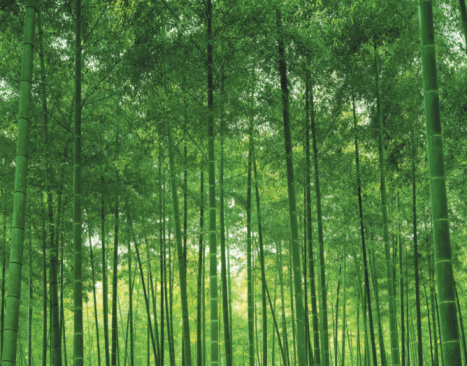
The closer we get to sustainable practices, the brighter the future looks for the generations ahead.
True sustainable construction is almost a magical, elusive thing, but bamboo might change all of that. Eco-friendly design is goal that’s there, but nearly a moving target. Seal a building to conserve energy, and thousands of school children get sick. Develop a paint with zero VOCs, and it wears off the first time that you clean the wall.
But what if it really was possible to work with a material that had no ecological drawbacks and that could be used for almost every element involved in the construction of a building? Engineering.com explains that architect Elora Hardy believes it’s possible with bamboo, and she’s proving every day in Bali.

Bamboo seems eager to participate in sustainable design.
Why Bamboo is Sustainable
By now, most people know that bamboo isn’t wood after all. It’s a grass, and an almost alarmingly fast growing one. Hundreds of different species exist, and the construction industry only uses a handful of them. The deforestation that occurs with harvesting lumber is a nonissue.
Bamboo requires very little special treatment to thrive like it should. It grows in areas where many other plants couldn’t survive. And when harvested, it automatically replenishes itself to a fully usable height within about 3 years. New shoots pop up on their own, so new bamboo isn’t planted; Nature handles that.
Challenges of Working With Bamboo
The drawbacks with bamboo have nothing to do with sustainability, and everything to do with developing a whole new skill set, according to hardy. Few, if any of the architectural rules that apply to traditional building materials work with bamboo. Poles aren’t straight, and they’re narrower at one end. They’re hollow, and they’re also ridged.
Two major barriers prevent widespread use of bamboo, but they have largely been overcome. Bamboo is susceptible to insect infestation, and it also degrades rather quickly when exposed to the elements. Structures have been built using bamboo for thousands of years, but they never lasted until now. A simple treatment with borax was all that it took.
What This Means for Construction
You won’t find 4 x 8 sheets of bamboo wallboard, and good luck trying to locate traditional posts, beams, and other lumber. What you will find is a material that’s resilient, flexible, lightweight, and durable enough to build a house or a school. This also means that building with bamboo is as much art and experimentation as it is engineering.
For the most part, you can’t make a set of drawings and then replicate them on site, because no two bamboo poles are the same. Hardy says her method is to build a scale model, and then painstakingly adjust and readjust using the materials that are available until the model has been reproduced. Bamboo model making and bamboo construction are art forms where engineering skills are not just handy, but a requirement.
The search for sustainable design isn’t necessarily over just because humans have finally learned how to use bamboo efficiently. But this is one step among many developments that can change the course construction, and it’s a big one.
PDH Academy is there for engineers, offering the professional development hours that you need to remain active and up-to-date with what’s happening in the industry. When your next requirements are due, check out our courses and see what’s new and exciting in the vibrant and progressive world of engineering.







